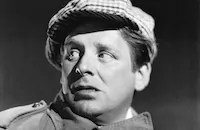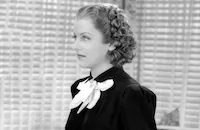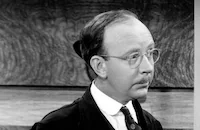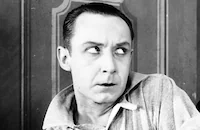Headline Shooter

Brief Synopsis
Cast & Crew
Otto Brower
William Gargan
Frances Dee
Ralph Bellamy
Jack Larue
Gregory Ratoff
Film Details
Technical Specs

Synopsis
While shooting film footage of an earthquake, newsreel cameraman Bill Allen meets and quarrels with newspaper reporter Jane Mallory, whose "sob sister" column Bill loathes. Not to be outdone by the other, both "news hounds" rush to the site of an emergency operating room, where a baby is being delivered by flashlight. Although the night's crises have brought them together, Jane resists Bill's romantic overtures and later explains to him that she has a fiancé in Riverport, Mississippi, and is looking forward to settling down in pampered security. Bill, who enjoys a reputation as a carefree heartbreaker, tries to persuade Jane to marry him, but seriously damages his chances by running off in the middle of his plea to cover a brewery fire.
At the fire, Bill's best friend Mike is killed while trying to get a "better shot" of the flames, which Bill suspects were started by gangster Ricci. Shocked by Mike's death, Bill receives another blow when he learns that Jane has left for Riverport to marry her fiancé, banker Hal Caldwell. Soon after, Bill accepts an assignment to cover a flood in the Riverport area and meets up with Jane and Hal. With Hal's help, Bill and Jane discover that the flooding was the result of a crack in a cheaply constructed levee. Although Bill is begged by Judge Beacon, whose dishonest son-in-law was responsible for the levee construction, to destroy his film, he refuses.
Consequently, when Beacon commits suicide after the newsreel's opening, Jane angrily rejects Bill and re-commits herself to marrying Hal. Before leaving with Hal, however, Jane rushes to hear the deathbed confession of a gangster's moll, which implicates Burnett, the gangster, in a murder and leads to Jane's kidnapping. Through clever editing of the brewery fire footage, Bill is able to force Ricci, a cohort of Burnett's, into revealing Jane's whereabouts. After a shootout with the gangsters, Bill rescues Jane, who then agrees to marry her news rival.

Director
Otto Brower
Cast

William Gargan

Frances Dee

Ralph Bellamy

Jack Larue

Gregory Ratoff

Wallace Ford

Robert Benchley

Betty Furness

Hobart Cavanaugh
June Brewster

Franklin Pangborn

Dorothy Burgess
Purnell Pratt

Henry B. Walthall
Bill Hudson

Mary Maclaren
Kitty Kelly
Crew
Merian C. Cooper
Al D'agostino
Agnes Christine Johnston
Fred Knudtson
Arthur Kober
David Lewis
Ray Lissner
Hugh Mcdowell Jr.
Nick Musuraca
Van Nest Polglase
Allen Rivkin
Max Steiner

Videos
Movie Clip


Film Details
Technical Specs

Articles
Headline Shooter
In a bawdy Pre-Code opening scene, the film fades in on a shot of a bedside, with a man's hat on a bedpost and a woman's clothes draped on the side. A woman is heard saying, "No. Please. I just can't go through with it." A man's voice replies, "Well this is a fine time to tell me." The camera pulls back and Betty Kane (June Brewster) is in bed wearing black lingerie and eating crackers while Phototone newsreel photographer Bill Allen (William Gargan) is taking still photos of her. Allen intends to scoop his competition the next day by getting exclusive footage of a beauty contest winner in advance - by rigging the contest which is being judged by the owner (Franklin Pangborn) of Crocker's Crackers. Allen, along with his friend and competitor Mike (Wallace Ford) will do almost anything to get a scoop; as he says, "it takes more than a cheesebox full of film to make a newsreel." At the site of earthquake damage, Allen is faking some footage of a baby rescue when he meets up with print reporter Jane Mallory (Frances Dee). Mallory is intending to quit the reporting game to settle down in Mississippi and marry her dull fiancé, banker Hal Caldwell (Ralph Bellamy). When Allen is sent to Mississippi to cover a flood, Mallory can't resist joining him in exposing the political corruption that led to poor construction on the levees which failed the community.
In his book Pre-code Hollywood: Sex, Immorality, and Insurrection in American Cinema; 1930-1934 (Columbia University Press, 1999), Thomas Patrick Doherty writes that the newsreels, turned out twice a week by five different studios, were very profitable during the Depression years. In 1933, the year that Headline Shooter was made, for example, "...the estimated cost for 104 issues of a newsreel, a complete year's run, was a little in excess of $1.4 million, or about the price of a single expensive A feature. The total costs for the five newsreels was estimated at a little under $10 million, with box office revenues yearly at $19.5 million." Yet despite the prestige factor and the relative freedom from censorship that the newsreel companies enjoyed, "...the newsreels tended to tremble before authority and turn a blind eye to the urgent issues of the day. At times, the deference to politicians was abject, the avoidance of the Great Depression stupefying."
According to Doherty, "...government officials pushed the newsreels around with a high-handedness they would never have ventured to show the print press. They denied access, restricted photography, confiscated cameras, and destroyed footage." He brings up Headline Shooter, remarking that it "offers a glimpse into the off screen pressures on the newsreel," and describes a sequence from the film, set in Mississippi, as Allen gets footage of the flooding and the shoddy concrete work that led to the failure of the levees. Local authorities confront Allen, Mallory, and Caldwell and use a variety of methods to persuade him to destroy the film. First they appeal to his humanity, saying the local judge was himself a victim. When that ploy fails, they threaten force. Allen pretends to comply, taking film footage and throwing it in a fire - the nitrate film is instantly engulfed, but Allen has only destroyed unexposed film and he later brags to his friends that his footage is "playing in theaters now." As Doherty writes, "He has done the right thing, his colleagues agree. 'That's the trouble with this country - there's too much covering up of things that ought to come out in the open. News is news and belongs to the public.' That sentiment, however, was Hollywood pretense, not newsreel policy."
Headline Shooter benefits from a wildly appealing cast. Nearly forgotten today, William Gargan was an inescapable leading man or second lead in over 50 films in the 1930s. The Brooklyn-born actor often played tough guys with an Irish bent; cops, soldiers, gangsters, etc. His output slowed in the 1940s, but he appeared as sleuth Ellery Queen in a series for Columbia Pictures and turned in a sensitive performance in Leo McCarey's The Bells of St. Mary's (1945). In the 1950s, Gargan found fame on television, starring in two separate series as Martin Kane, Private Investigator.
Frances Dee would score other important lead parts in the same year she appeared in Headline Shooter, in Little Women (as Meg) and in the shockingly violent Pre-Code crime drama Blood Money. Ralph Bellamy is on hand to personally play the "Ralph Bellamy role" - that of the other man in the life of the heroine. Fresh from his brutal turn as "Trigger" in The Story of Temple Drake (1933), Jack La Rue was borrowed from Paramount Pictures for a more gullible gangster in Headline Shooter. The film is also peppered with other recognizable players such as Wallace Ford, Gregory Ratoff, Betty Furness, the always-welcome Franklin Pangborn, and, in an amusing cameo as a radio announcer doing the play-by-play of a beauty contest, Robert Benchley.
Executive Producer: Merian C. Cooper
Director: Otto Brower
Screenplay: Agnes Christine Johnston, Allen Rivkin (writers); Wallace West (story "Muddy Waters"); Arthur Kober (additional dialogue)
Cinematography: Nick Musuraca
Se Decoration: Albert S. D'Agostino, Van Nest Polglase
Musical Director: Max Steiner
Film Editing: Frederic Knudtson
Cast: William Gargan (Bill Allen), Frances Dee (Jane Mallory), Ralph Bellamy (Hal Caldwell), Jack La Rue (Ricci), Gregory Ratoff (Gottlieb), Wallace Ford (Mike), Robert Benchley (Radio Announcer), Betty Furness (Miss Saunders, secretary), Hobart Cavanaugh (Happy), June Brewster (Betty Kane)
BW-62m.
by John M. Miller

Headline Shooter
Quotes
Trivia
Notes
Pre-release news items, including Motion Picture Herald's "In the Cutting Room," list the title of the film as Headline Shooters. Helen Mack was originally slated to star in the production, according to a May 15, 1933 Film Daily news item. A March 1933 Film Daily news item announced that RKO had hired Sarah Y. Mason and William A. Ullman, Jr. to collaborate on a screenplay called News Reel. It is possible that News Reel was a working title for this film. Eric Linden was announced in a May 1, 1933 Film Daily news item as a cast member of News Reel. According to the New York Times, "several actual news-reel shots" were edited into the film. RKO borrowed Jack LaRue from Paramount for the production. According to Hollywood Reporter news items, William LeMaire and Edward Keane were to be in the cast, but their participation in the final film has not been confirmed.














